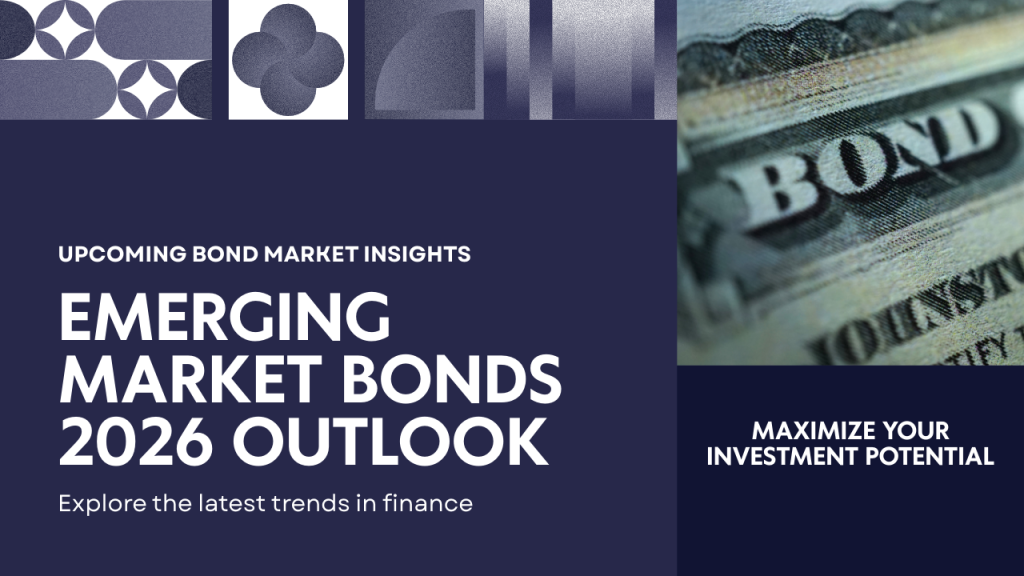
Looking Ahead: EM Bonds in 2026
Emerging Market (EM) bonds enter 2026 at a critical inflection point. After a volatile 2024–2025 cycle driven by U.S. rate hikes, currency depreciation, and capital outflows, EM fixed income is regaining attention. With the U.S. Federal Reserve expected to shift toward gradual easing in mid-2026, EM bonds stand to benefit from improved liquidity, stabilizing currencies, and narrowing risk premiums.
For global investors, EM bonds in 2026 represent both yield opportunities and diversification benefits. Yet the market will remain highly selective, with winners defined by fiscal discipline, credible monetary frameworks, and integration into global capital flows.
Macro Backdrop for EM Bonds in 2026
Global Interest Rate Environment
- Fed expected to cut rates by ~75–100bps during 2026.
- ECB and BOE likely to follow with modest easing.
- Lower global yields enhance attractiveness of EM carry trades.
EM Yield Differentials
- Average EM local yields: ~6.0% vs ~3.5% in developed markets.
- Real yields remain positive in many EM economies (Brazil, Mexico, South Africa).
Currency Stability
- Stabilization of EM FX in 2025 reduces hedging costs.
- Stronger fundamentals in India, Mexico, Indonesia attract FX-sensitive inflows.
Sovereign Bonds
Investment Grade (IG) EM Sovereigns
- Korea, GCC (Saudi Arabia, Qatar, UAE), and Chile remain safe havens within EM.
- Low spreads, but provide stability in global EM portfolios.
High-Yield Sovereigns
- Brazil, South Africa, and Indonesia offer attractive yields (~7–9%).
- Risks include fiscal slippage and political uncertainty.
Frontier Sovereigns
- Nigeria, Kenya, and Egypt present double-digit yields but high default risk.
- Selective opportunities in restructuring stories with IMF backing.
Corporate Bonds
Issuance Trends
- EM corporates expected to issue ~$1 trillion in 2026.
- Strong demand from Asian banks and European investors.
Sector Leaders
- Energy & Mining: Brazil, Indonesia, Chile.
- Financials: Indian and Mexican banks expanding issuance.
- ESG-linked issuance: Green and sustainable bonds growing at >20% annually.
Credit Quality
- Overall EM corporate defaults remain below historical averages.
- Stronger balance sheets in Korea, India, and Mexico corporates.
Interim Insights (Mid-2026 View)
- EM sovereign bonds likely to outperform in a lower global yield environment.
- Corporate bonds provide spread compression opportunities in financials and green energy.
- Investors should differentiate between high-beta frontier plays and stable IG allocations.
Risk Scenarios for EM Bonds in 2026
- Delayed Fed Easing
- If inflation remains sticky in the U.S., EM bond spreads may widen again.
- China Slowdown
- Lower commodity demand impacts fiscal stability of exporters (Brazil, Chile, Indonesia).
- Geopolitical Shocks
- Middle East instability, South China Sea tensions, or African sovereign defaults could trigger sell-offs.
- Climate Risks
- Extreme weather could pressure fiscal budgets (food subsidies, infrastructure repair).
Investment Strategy Recommendations
Local Currency Bonds
- Overweight: Mexico, India, Indonesia — high real yields, currency stability.
- Underweight: Turkey, Argentina — inflation and policy credibility issues.
Hard Currency Bonds (USD-denominated)
- IG Sovereigns: Korea, GCC, Chile — defensive allocations.
- HY Sovereigns: Brazil, South Africa — attractive spreads with manageable risks.
Corporate Bonds
- Favor financials (India, Mexico) and green energy corporates (Chile, Korea).
- Selective allocation to high-quality issuers in commodity sectors.
Portfolio Construction Ideas
- Balanced EM Bond Portfolio (2026)
- 50% Local currency sovereigns (India, Mexico, Indonesia, South Africa)
- 30% Hard currency sovereigns (Korea, GCC, Chile)
- 20% Corporates (financials + green energy issuers)
- High-Yield Tilted Portfolio
- Focus on Brazil, South Africa, Indonesia for carry.
- Tactical positions in frontier sovereigns with IMF backing.
Key Takeaways for 2026 EM Bonds
EM bonds are poised to deliver strong relative returns in 2026, supported by Fed easing, attractive yield differentials, and stabilizing currencies. However, performance will be highly differentiated: disciplined fiscal managers and ESG-aligned issuers will attract flows, while weak-policy sovereigns will face ongoing stress.
Leave a Reply